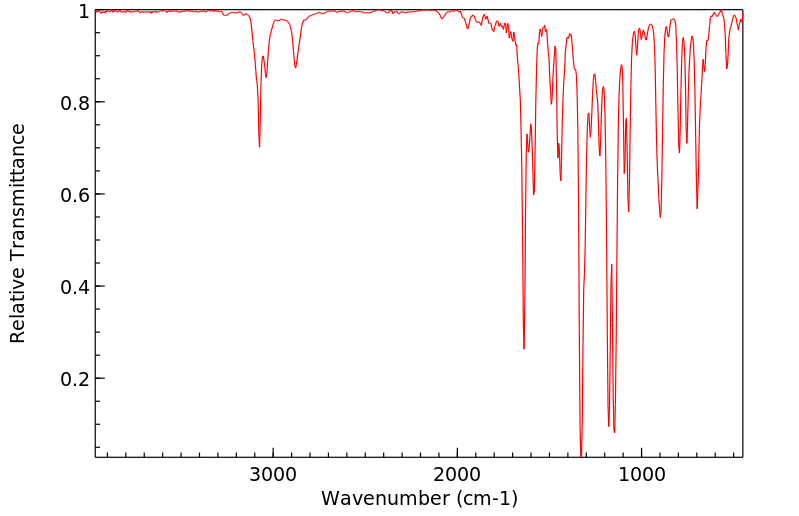2,2,2-trifluoro-N,1-diphenylethan-1-imine | 37772-00-2
中文名称
——
中文别名
——
英文名称
2,2,2-trifluoro-N,1-diphenylethan-1-imine
英文别名
2,2,2-Trifluoro-N,1-diphenylethanimine
CAS
37772-00-2
化学式
C14H10F3N
mdl
——
分子量
249.235
InChiKey
WOGGGKUXOZTMID-UHFFFAOYSA-N
BEILSTEIN
——
EINECS
——
-
物化性质
-
计算性质
-
ADMET
-
安全信息
-
SDS
-
制备方法与用途
-
上下游信息
-
文献信息
-
表征谱图
-
同类化合物
-
相关功能分类
-
相关结构分类
物化性质
-
沸点:248.5±40.0 °C(Predicted)
-
密度:1.13±0.1 g/cm3(Predicted)
计算性质
-
辛醇/水分配系数(LogP):4.6
-
重原子数:18
-
可旋转键数:2
-
环数:2.0
-
sp3杂化的碳原子比例:0.07
-
拓扑面积:12.4
-
氢给体数:0
-
氢受体数:4
反应信息
-
作为反应物:描述:2,2,2-trifluoro-N,1-diphenylethan-1-imine 在 sodium formate 作用下, 以 水 为溶剂, 反应 18.0h, 以95%的产率得到(S)-N-(2,2,2-trifluoro-1-phenylethyl)aniline参考文献:名称:两亲性超支化聚乙氧基硅氧烷:一种自模板组装平台,用于制备功能性介孔结构二氧化硅,用于水对映选择性反应摘要:作为非均相催化剂的两亲介观结构的二氧化硅的制备由于其在水中的高度分散性而有利于促进水反应。在这项工作中,通过利用自模板组装策略的优势,我们通过使用两亲性聚(乙二醇)单甲醚改性的超支化聚乙氧基硅氧烷作为二氧化硅前体。如研究中所述,手性钌/二胺官能化催化剂在水中将无环α-三氟甲基亚胺进行不对称转移氢化成手性α-三氟甲胺,而手性方酰胺功能化的催化剂能够将乙酰丙酮高效不对称地迈克尔加成到盐水中的硝基烯烃上。两种高催化性能均归因于明确定义的单中心手性活性物种,高度分散的催化中心和实用的相转移功能的组合多功能性。此外,两种催化剂也可以容易地回收并重复使用至少七次而不会损失催化活性。这样的特征使得该自模板组件对于构造各种非均相催化剂具有吸引力。和实用的相转移功能。此外,两种催化剂也可以容易地回收并重复使用至少七次而不会损失催化活性。这样的特征使得该自模板组件对于构造各种非均相催化剂具有吸引力。和实用的相DOI:10.1021/acscatal.6b01315
-
作为产物:描述:参考文献:名称:Acyclic amides as estrogen receptor ligands: Synthesis, binding, activity and receptor interaction摘要:We have prepared a series of bisphenolic amides that mimic bibenzyl and homobibenzyl motifs commonly found as substructures in ligands for the estrogen receptor (ER). Representative members were prepared from three classes: N-phenyl benzamides, N-phenyl acetamides, and N-benzyl benzamides; in some cases the corresponding thiocarboxamides and sulfonamides were also prepared. Of these three classes, the N-phenyl benzamides had the highest affinity for ER, the N-phenyl acetamides had lower, and the N-benzyl benzamides were prone to fragmentation via a quinone methide intermediate. In the N-phenyl benzamide series, the highest affinity analogues had bulky N-substituents; a CF3 group, in particular, conferred high affinity. The thiocarboxamides bound better than the corresponding carboxamides and these bound better than the corresponding sulfonamides. Binding affinity comparisons suggest that the p-hydroxy group on the benzoate ring, which contributes most to the binding, is playing the role of the phenolic hydroxyl of estradiol. Computational studies and NMR and X-ray crystallographic analysis indicate that the two anilide systems studied have a strong preference for the s-cis or exo amide conformation, which places the two aromatic rings in a syn orientation. We used this structural template. together with the X-ray structure of the ER ligand binding domain, to elaborate an additional hydrogen bonding site on a benzamide system that elevated receptor binding further. When assayed on the individual ER subtypes, ER alpha and ER beta, these compounds show modest binding affinity preference for ER alpha. In a reporter gene transfection assay of transcriptional activity, the amides generally have full to nearly full agonist character on ERa, but have moderate to full antagonist character on ER beta. One high affinity carboxamide is 500-fold more potent as an agonist on ER alpha than on ER beta. This work illustrates that ER ligands having simple amide core structures can be readily prepared, but that high affinity binding requires an appropriate distribution of bulk, polarity, and functionality. The strong conformational preference of the core anilide function in all of these ligands defines a rather rigid geometry for further structural and functional expansion of these series. (C) 2000 Elsevier Science Ltd. All rights reserved.DOI:10.1016/s0968-0896(00)00075-4
文献信息
-
H <sub>2</sub> Activation by Non‐Transition‐Metal Systems: Hydrogenation of Aldimines and Ketimines with LiN(SiMe <sub>3</sub> ) <sub>2</sub>作者:Daniel C. Elliott、Alex Marti、Pablo Mauleón、Andreas PfaltzDOI:10.1002/chem.201805549日期:2019.2.6In recent years, H2 activation at non‐transition‐metal centers has met with increasing attention. Here, a system in which H2 is activated and transferred to aldimines and ketimines using substoichiometric amounts of lithium bis(trimethylsilyl)amide is reported. Notably, the reaction tolerates the presence of acidic protons in the α‐position. Mechanistic investigations indicated that the reaction proceeds
-
Rhodium-Catalyzed C═N Bond Formation through a Rebound Hydrolysis Mechanism and Application in β-Lactam Synthesis作者:Long Chen、Linxing Zhang、Ying Shao、Guangyang Xu、Xinhao Zhang、Shengbiao Tang、Jiangtao SunDOI:10.1021/acs.orglett.9b01312日期:2019.6.7this transformation proceeds via a novel rebound hydrolysis mechanism. Furthermore, a three-component reaction was explored to synthesize highly functionalized β-lactams in good yields and diastereoselectivities.
-
Synthesis of Aziridines by Palladium-Catalyzed Reactions of Allylamines with Aryl and Alkenyl Halides: Evidence of a<i>syn</i>-Carboamination Pathway作者:Sayuri Hayashi、Hideki Yorimitsu、Koichiro OshimaDOI:10.1002/anie.200903178日期:2009.9.14rings: Treatment of N‐arylallylamine with an aryl or alkenyl halide under palladium catalysis (see scheme; dba=dibenzylideneacetone, SPhos=2‐dicyclohexylphosphanyl‐2′,6′‐dimethoxybiphenyl) resulted in intramolecular cyclization to form the arylmethyl‐substituted aziridine with concomitant CC bond formation. The experiments for the elucidation of the reaction mechanism are also described.
-
Synthesis of N-substituted α,α-difluoro-β-aminophosphonates by addition of diethyl lithiodifluoromethylphosphonate to imines作者:Prabhakar Cherkupally、Petr BeierDOI:10.1016/j.jfluchem.2012.06.004日期:2012.9Addition of diethyl lithiodifluoromethylphosphonate to N-substituted imines provides N-substituted α,α-difluoro-β-aminophosphonates. N-Alkyl, aryl, or Boc substituted aldimines give good to high yields in these reactions, while in ketimine series, only activated N-(2,2,2-trifluoro-1-phenylethylidene)aniline showed high reactivity.
-
Photoredox-Catalyzed Synthesis of α-Amino Acid Amides by Imine Carbamoylation作者:Luana Cardinale、Mattis-Ole W. S. Schmotz、Mikhail O. Konev、Axel Jacobi von WangelinDOI:10.1021/acs.orglett.1c03908日期:2022.1.21An operationally simple protocol for the photocatalytic carbamoylation of imines is reported. Easily available, bench-stable 4-amido Hantzsch ester derivatives serve as precursors to carbamoyl radicals that undergo rapid addition to N-aryl imines. The reaction proceeds under blue light irradiation in the presence of the photocatalyst 3DPAFIPN and Brønsted/Lewis acid additives. Mechanistic studies indicated
表征谱图
-
氢谱1HNMR
-
质谱MS
-
碳谱13CNMR
-
红外IR
-
拉曼Raman
-
峰位数据
-
峰位匹配
-
表征信息
同类化合物
(βS)-β-氨基-4-(4-羟基苯氧基)-3,5-二碘苯甲丙醇
(S,S)-邻甲苯基-DIPAMP
(S)-(-)-7'-〔4(S)-(苄基)恶唑-2-基]-7-二(3,5-二-叔丁基苯基)膦基-2,2',3,3'-四氢-1,1-螺二氢茚
(S)-盐酸沙丁胺醇
(S)-3-(叔丁基)-4-(2,6-二甲氧基苯基)-2,3-二氢苯并[d][1,3]氧磷杂环戊二烯
(S)-2,2'-双[双(3,5-三氟甲基苯基)膦基]-4,4',6,6'-四甲氧基联苯
(S)-1-[3,5-双(三氟甲基)苯基]-3-[1-(二甲基氨基)-3-甲基丁烷-2-基]硫脲
(R)富马酸托特罗定
(R)-(-)-盐酸尼古地平
(R)-(-)-4,12-双(二苯基膦基)[2.2]对环芳烷(1,5环辛二烯)铑(I)四氟硼酸盐
(R)-(+)-7-双(3,5-二叔丁基苯基)膦基7''-[((6-甲基吡啶-2-基甲基)氨基]-2,2'',3,3''-四氢-1,1''-螺双茚满
(R)-(+)-7-双(3,5-二叔丁基苯基)膦基7''-[(4-叔丁基吡啶-2-基甲基)氨基]-2,2'',3,3''-四氢-1,1''-螺双茚满
(R)-(+)-7-双(3,5-二叔丁基苯基)膦基7''-[(3-甲基吡啶-2-基甲基)氨基]-2,2'',3,3''-四氢-1,1''-螺双茚满
(R)-(+)-4,7-双(3,5-二-叔丁基苯基)膦基-7“-[(吡啶-2-基甲基)氨基]-2,2”,3,3'-四氢1,1'-螺二茚满
(R)-3-(叔丁基)-4-(2,6-二苯氧基苯基)-2,3-二氢苯并[d][1,3]氧杂磷杂环戊烯
(R)-2-[((二苯基膦基)甲基]吡咯烷
(R)-1-[3,5-双(三氟甲基)苯基]-3-[1-(二甲基氨基)-3-甲基丁烷-2-基]硫脲
(N-(4-甲氧基苯基)-N-甲基-3-(1-哌啶基)丙-2-烯酰胺)
(5-溴-2-羟基苯基)-4-氯苯甲酮
(5-溴-2-氯苯基)(4-羟基苯基)甲酮
(5-氧代-3-苯基-2,5-二氢-1,2,3,4-oxatriazol-3-鎓)
(4S,5R)-4-甲基-5-苯基-1,2,3-氧代噻唑烷-2,2-二氧化物-3-羧酸叔丁酯
(4S,4''S)-2,2''-亚环戊基双[4,5-二氢-4-(苯甲基)恶唑]
(4-溴苯基)-[2-氟-4-[6-[甲基(丙-2-烯基)氨基]己氧基]苯基]甲酮
(4-丁氧基苯甲基)三苯基溴化磷
(3aR,8aR)-(-)-4,4,8,8-四(3,5-二甲基苯基)四氢-2,2-二甲基-6-苯基-1,3-二氧戊环[4,5-e]二恶唑磷
(3aR,6aS)-5-氧代六氢环戊基[c]吡咯-2(1H)-羧酸酯
(2Z)-3-[[(4-氯苯基)氨基]-2-氰基丙烯酸乙酯
(2S,3S,5S)-5-(叔丁氧基甲酰氨基)-2-(N-5-噻唑基-甲氧羰基)氨基-1,6-二苯基-3-羟基己烷
(2S,2''S,3S,3''S)-3,3''-二叔丁基-4,4''-双(2,6-二甲氧基苯基)-2,2'',3,3''-四氢-2,2''-联苯并[d][1,3]氧杂磷杂戊环
(2S)-(-)-2-{[[[[3,5-双(氟代甲基)苯基]氨基]硫代甲基]氨基}-N-(二苯基甲基)-N,3,3-三甲基丁酰胺
(2S)-2-[[[[[((1S,2S)-2-氨基环己基]氨基]硫代甲基]氨基]-N-(二苯甲基)-N,3,3-三甲基丁酰胺
(2S)-2-[[[[[[((1R,2R)-2-氨基环己基]氨基]硫代甲基]氨基]-N-(二苯甲基)-N,3,3-三甲基丁酰胺
(2-硝基苯基)磷酸三酰胺
(2,6-二氯苯基)乙酰氯
(2,3-二甲氧基-5-甲基苯基)硼酸
(1S,2S,3S,5S)-5-叠氮基-3-(苯基甲氧基)-2-[(苯基甲氧基)甲基]环戊醇
(1S,2S,3R,5R)-2-(苄氧基)甲基-6-氧杂双环[3.1.0]己-3-醇
(1-(4-氟苯基)环丙基)甲胺盐酸盐
(1-(3-溴苯基)环丁基)甲胺盐酸盐
(1-(2-氯苯基)环丁基)甲胺盐酸盐
(1-(2-氟苯基)环丙基)甲胺盐酸盐
(1-(2,6-二氟苯基)环丙基)甲胺盐酸盐
(-)-去甲基西布曲明
龙蒿油
龙胆酸钠
龙胆酸叔丁酯
龙胆酸
龙胆紫-d6
龙胆紫







